Hawaii is nothing if not a full-bodied, sensory experience. Its glorious sights—stunning beaches, verdant rainforests, lofty waterfalls—are often lauded, but it equally delights one’s nose, ears, taste buds, and touch. From heavenly cuisine and slack-key music to the, velvety sultry air, there’s no wonder why the sensual Aloha State is considered synonymous with Eden.
The flowers of Hawaii contribute to this bliss. Whether they’re blooming outside the window of your Airbnb, flourishing in Hana’s wilderness, or prospering on a boutique farm, Hawaii’s flowers—wild, diverse, sometimes radical—substantially add to the islands’ magic. Here are 9 of its most iconic blooms you may come across while riding on our Maui bike tours: some endemic, some introduced—and all enthralling in their beauty.
Anthurium
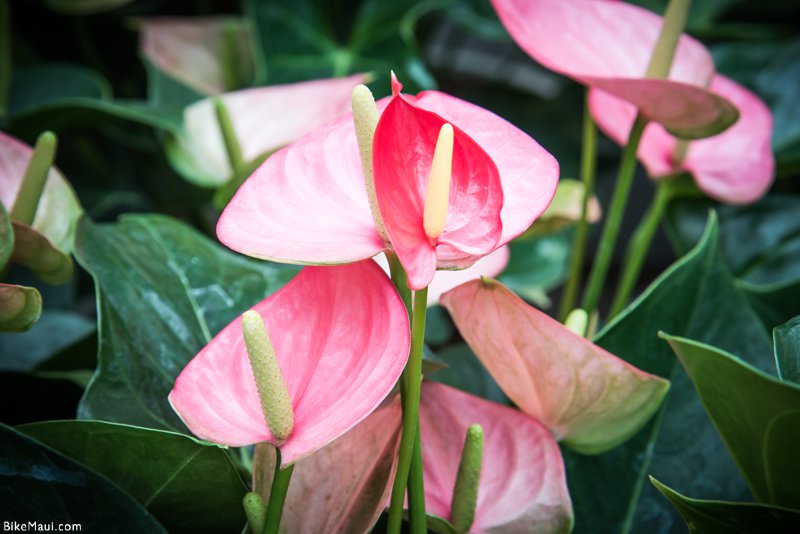
Sleek, waxy, shaded in reds and pinks, and shaped like a heart: There’s something downright sexy about anthuriums. Native to the Americas—specifically Argentina and Northern Mexico—the houseplant and garden gem thrives in the tropics, first arriving in Hawaii in 1889 when Hawaii’s Minister of Finance, Samuel Mills Damon, returned from England with a stem and planted it in his garden. Beginning in 1936, hobbyists throughout the islands began cultivating the flower, leading to developments that include the Ozaki (a red anthurium grown in Hilo) and the Starlight—the first anthurium to be patented.
Bird of Paradise
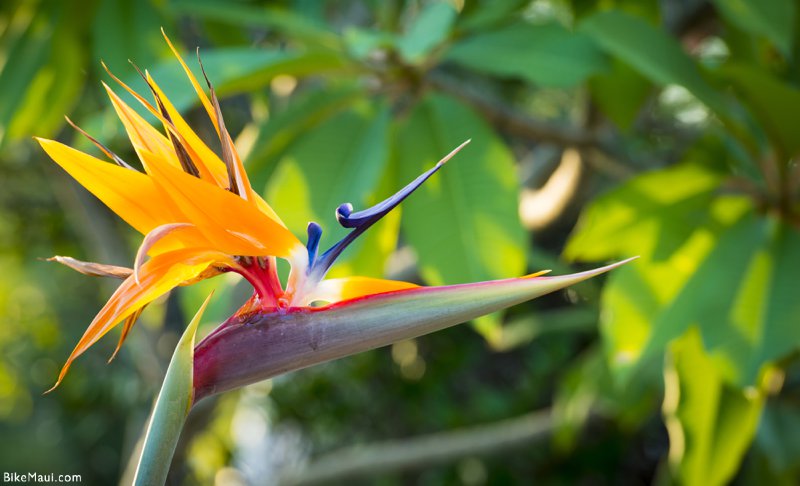
Few blooms strike as much joy and awe as a bird of paradise. With its vibrant orange petals—and a touch of iris spiking through—the exoticism of the flower has become emblematic of the islands, thanks in part to Georgia O’Keefe, whose time in Hawaii in the 1940s inspired her renowned piece, “White Bird of Paradise.” Known as a “crane flower” in South Africa—where it originally hails from—the striking bloom bears similarities to the banana.
Hawaiian Gardenia
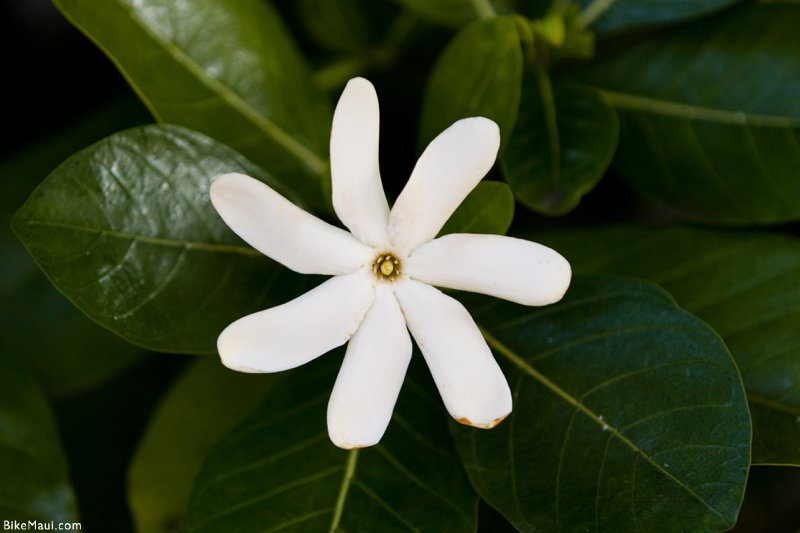
Native to the Aloha State, Hawaiian Gardenia—or na’u—is one of the most fragrant flowers in the islands; found in bunches, and their scent is practically its own presence. Its alabaster hue only adds to its facility to amaze and haunt. Part of the coffee family, the flower was once prevalent on all of the Hawaiian Islands; today, it’s a federally-list endangered species with only a few plants remaining in the wild. In other words? You ought to feel blessed if you happen upon one.
Pikake
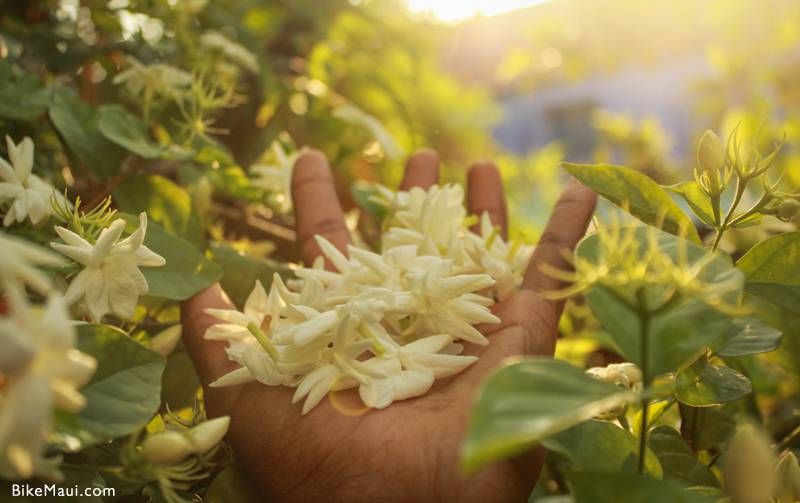
Offering what is arguably the most wonderful scent in Hawaii, pikake went down in Hawaiian history as the favorite flower of its famed “Crown” princess, Ka‘iulani—heir to the throne of the Kingdom of Hawaii before the overthrow of the Hawaiian Monarchy. Meaning peacock in Hawaiian, pikake—which is also known as Indian and Arabian Jasmine and is part of the olive family—produces such a magnificent aroma, it’s one of the top-selling perfumes to come out of Hawaii. With four distinct flower varieties throughout the islands, it appears in lei and gardens, lacing many romantic nights with its irresistible fragrance.
Blue Ginger
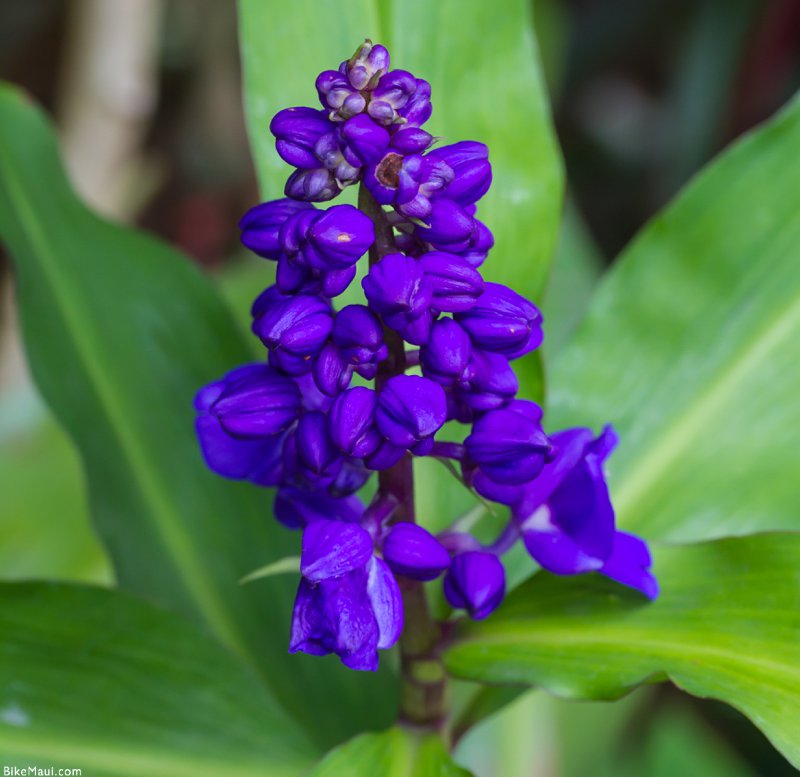
While awapuhi grows in abundance throughout the islands—with those pink and red crowns a large part of resort grounds—blue ginger, or Dichorisandra thyrsiflora (which one can see at the Maui Tropical Plantation among many other varieties of beautiful vegetation), is a rarer encounter. Native to Brazil, and bearing similarities to spiderworts, its color—somewhere between sapphire and violet—astounds, rendering it noticeable, if not show-offy, even in the most colorful of gardens.
Hawaiian Hibiscus
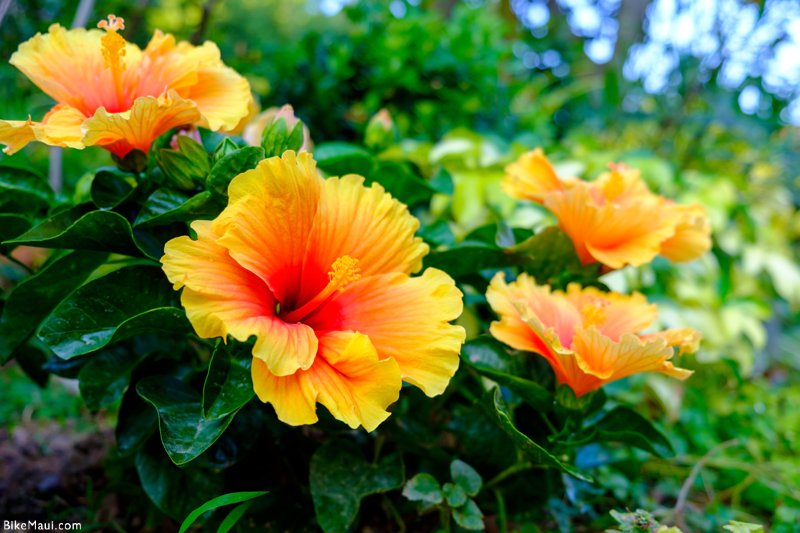
Hawaii is home to more than birds and plants found nowhere else on Earth: It’s also home to seven types of hibiscus that are endemic to the islands—but what most visitors and locals see are Chinese hibiscus and their hybrids. Nevertheless, the jazzy, vivid flower, in hues ranging from bright pink to white, has come to symbolize Hawaii, with the yellow hibiscus, also known as pua alo alo, serving as the state’s flower. A fixture throughout the islands, hibiscus bloom daily but say aloha ‘oe to their petals almost as quickly—most hibiscus seldom last most beyond sunset.
Plumeria
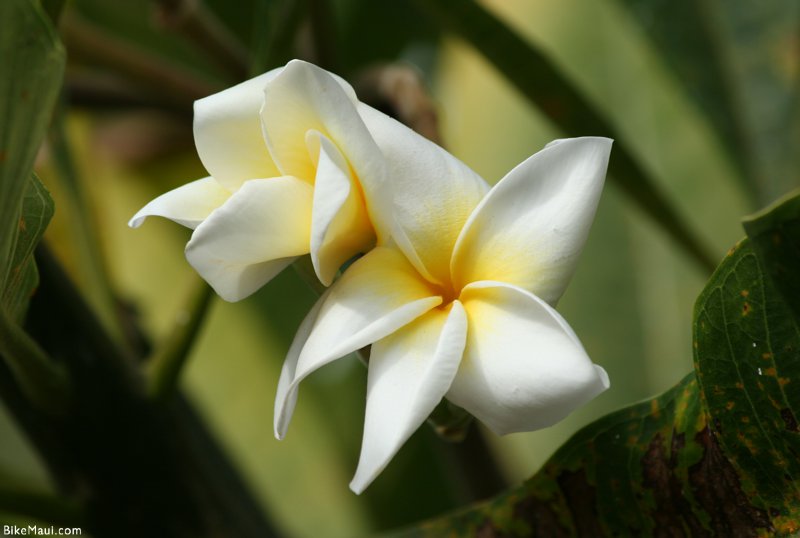
Backyard staple, resort landscaping basic, beach ornamental—plumeria trees are as ubiquitous in Hawaii as palms, dazzling eyes with their range of colors (from scarlet red to white with a buttery-yellow center)—and dazzling noses with their sweet, perfumed scent. Brought to the islands by a German botanist in 1860, they’re the bloom you pin behind your ear on your way out to dinner, and, if you’re kama’aina, the flower you reach for when it’s time to make lei for a birthday, baby’s first, or graduation. Stroll along coastal walks—such as the Wailea Boardwalk on Maui—and chances are you’ll find a plumeria lei drying in the sun on rocks near the water. Consider it a misguided interpretation of a tradition that began in WWII, when sailors departing Oahu threw their plumeria lei into the Pacific (a lei floating to shore assured their return; a lei floating back toward their ship suggested they wouldn’t). Should you receive a plumeria lei upon visiting Hawaii, ensure it isn’t just tossed in the trash: local ritual says the lei should be given back to Earth, hung from a tree, buried, or burned.
‘Uki ‘Uki (Hawaiian Lily)
Mere groundcover the ‘uki ‘uki—or Hawaiian Lily—is not. Generating spears of white flowers and buds of bluish-purple fruit year-round, Dianella sandwicensis is often strung into lei and used as a dye in kapa cloth. (Native Hawaiians also used it for cordage and thatch houses.) Endemic to the islands, ‘uki ‘uki adapts well to diverse environments, meaning it’s just as likely to flourish in arid climes as it is lush rainforests. (still looking for a great photo of these beauties. Let us know if you have a good one we can use!)
Naupaka
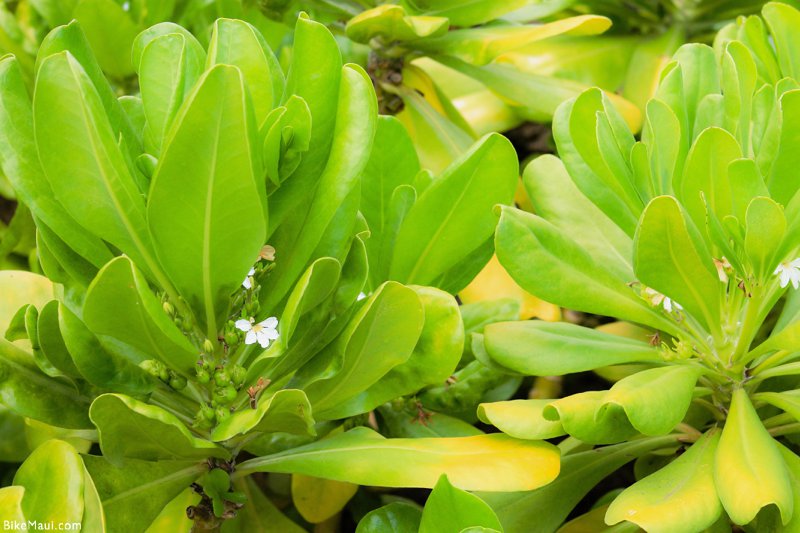
With their dark green leaves and compelling, half-broken white blooms, naupaka is seen from sea to sky. Or, in less poetic terms, it flourishes on both beaches and mountains. Native to Hawaii, and presenting an unmistakably pleasing scent (especially given its diminutive size), naupaka, like many Hawaiian flowers, has a myth behind it: According to legend, a princess named Naupaka fell madly in love with a plebe who she was banned from marrying. When a priest Hawaii’s Romeo and Juliet counseled said there was nothing he could do for them, a devastated Naupaka tore the white flower from her hair and ripped it in half. She gave one half of the flower to her lover and insisted he return to the beach; she, on the other hand, would stay in the mountains. Today, the “female” naupaka—which grows in the upper reaches of the islands—has a lovelier, more palpable scent than its robust “male” version on the beach. Whatever you may believe, you won’t be able to question its ability to tantalize—much like all of Hawaii.
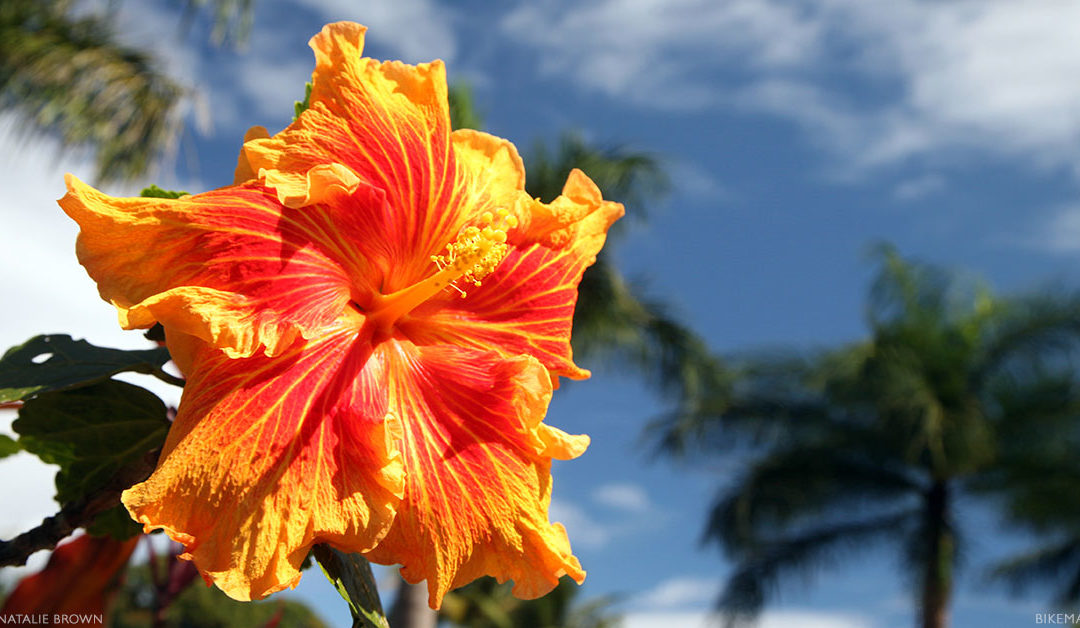



5 letter word of a yellow flower in Hawaii
ʻilima
also known as “Sida fallax”
i HAVE A PLANT THAT GROWS ON STALKS THAT LOOKS AND DURING IT GOES DORMANT THEN THE STALKS SLOWLY TURN GREEN AND SEND OUT RUNNERS THAT WILL PUT OUT THE MOST BEAUTIFUL FLOWERS THAT LAST A LONG TIME AND THEY SHIMMER IN THE LIGHT,THEY T
LOOK SO SHINNY I HAVE NO IDEA WHAT IT IS BUT IT LOOKS LIKE THE FLOWERS ON A LAI THEY GIVE YOU WHEN YOU GET TO hAWAII.HOW IS THE BEST CARE FOR THEM AND HELP THEM THRIVE?
AND ARE SIMPLY STUNNING I WOUL
I believe you are talking about orchids.
yes those are orchids like Gina said.
The flowers used on leis are plumerias, not orchids.
Dendrobium orchids are a popular lei flower as well.
Disappointed that you couldn’t find a better plumeria photo.
I thought it was fine. That is a perfectly fine picture to me.
We deal with all this flowers in our regular landscaping jobs in Hawaii. Plumeria, hibiscus, and gardenia are the most common ones and we love them!
Anyone know what Alpalupa means??
please send me prices for arrangements from Hawwai
What type of fertilizer should I use for the Hawaiian flower called Anthurium ? Does any one know ?
3 years ago we brought home 3 plumeria cuttings from Hawaii, they were about 12 inches long. They are now 6 ft tall and admired by all! It is getting to be a challenge to bring them in for the winter though, do they ever get to a size where they are resistant to cold? We are in Texas so not super cold but can get down below 40 at night with an occasional frost. We also had a seed pod on one of ours last year and grew about 50 seedlings from it!
what have I witnessed in this comment section. jeez. I love flowers, but man
I love this page!